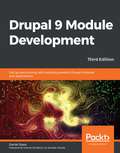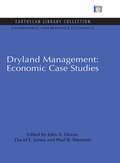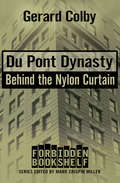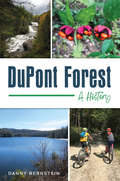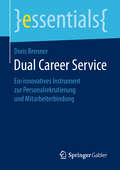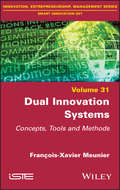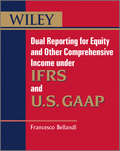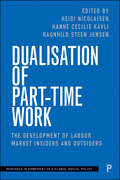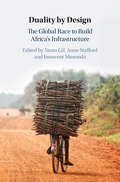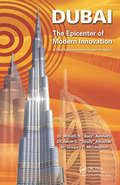- Table View
- List View
Drupal 9 Module Development: Get up and running with building powerful Drupal modules and applications, 3rd Edition
by Daniel Sipos Antonio De MarcoBuild and extend flexible Drupal sites and applications with this up-to-date, expert guide to Drupal 9 module development Key Features Explore the essential Drupal 9 APIs for module development Learn how to implement data modeling, caching, architecture, and much more in your Drupal applications Discover what's new in the latest Drupal core releases Book Description With its latest release, Drupal 9, the popular open source CMS platform has been updated with new functionalities for building complex Drupal apps with ease. This third edition of the Drupal Module Development guide covers these new Drupal features, helping you to stay on top of code deprecations and the changing architecture with every release. The book starts by introducing you to the Drupal 9 architecture and its subsystems before showing you how to create your first module with basic functionality. You'll explore the Drupal logging and mailing systems, learn how to output data using the theme layer, and work with menus and links programmatically. Once you've understood the different kinds of data storage, this Drupal guide will demonstrate how to create custom entities and field types and leverage the Database API for lower-level database queries. You'll also learn how to introduce JavaScript into your module, work with various file systems, and ensure that your code works on multilingual sites. Finally, you'll work with Views, create automated tests for your functionality, and write secure code. By the end of the book, you'll have learned how to develop custom modules that can provide solutions to complex business problems, and who knows, maybe you'll even contribute to the Drupal community! What you will learn Develop custom Drupal 9 modules for your applications Master different Drupal 9 subsystems and APIs Model, store, manipulate, and process data for effective data management Display data and content in a clean and secure way using the theme system Test your business logic to prevent regression Stay ahead of the curve and write PHP code by implementing best practices Who this book is for If you are a Drupal developer looking to learn Drupal 9 to write modules for your sites, this book is for you. Drupal site builders and PHP developers with basic object-oriented programming skills will also find this book helpful. Although not necessary, some Symfony experience will help with understanding concepts easily.
Dry: A Memoir
by Augusten Burroughs<P>You may not know it, but you've met Augusten Burroughs. You've seen him on the street, in bars, on the subway, at restaurants: a twenty-something guy, nice suit, works in advertising. Regular. Ordinary. <P>But when the ordinary person had two drinks, Augusten was circling the drain by having twelve; when the ordinary person went home at midnight, Augusten never went home at all. <P>Loud, distracting ties, automated wake-up calls, and cologne on the tongue could only hide so much for so long. <P>At the request (well, it wasn't really a request) of his employers, Augusten landed in rehab, where his dreams of group therapy with Robert Downey, Jr., are immediately dashed by the grim reality of fluorescent lighting and paper hospital slippers. <P>But when Augusten is forced to examine himself, something actually starts to click, and that's when he finds himself in the worst trouble of all. <P>Because when his thirty days are up, he has to return to his same drunken Manhattan life-and live it sober. What follows is a memoir that's as moving as it is funny, as heartbreaking as it is real. <P>Dry is the story of love, loss, and Starbucks as a higher power. <P><b>A New York Times Bestseller</b>
Dryland Management: Economic Case Studies (Environmental and Resource Economics Set)
by David E. James John A. Dixon Paul B. ShermanDrylands are a sizeable part of the world's potentially arable land. They vary from the hyper-arid regions of the classic deserts of Africa and Asia to the more common semi-arid and sub-humid areas that support extensive agricultural systems dependent on rainfall or irrigation. Following their successful and innovative work The Economics of Dryland Management the editors have assembled twenty case studies from nine countries in the continents of Africa, Asia, North America and Australia. They help to explore more fully the costs of land degradation and illustrate the economics of reclamation, rehabilitation and prevention. The cases in this book present a rich, varied and readable survey of a wide range of drylands and their resources. Originally published in 19990
Du Pont Dynasty: Behind the Nylon Curtain (Forbidden Bookshelf #6)
by Gerard ColbyAward-winning journalist Gerard Colby takes readers behind the scenes of one of America&’s most powerful and enduring corporations; now with a new introduction by the author Their name is everywhere. America&’s wealthiest industrial family by far and a vast financial power, the Du Ponts, from their mansions in northern Delaware&’s &“Chateau Country,&” have long been leaders in the relentless drive to turn the United States into a plutocracy. The Du Pont story in this country began in 1800. Éleuthère Irénée du Pont, official keeper of the gunpowder of corrupt King Louis XVI, fled from revolutionary France to America. Two years later he founded the gunpowder company that called itself &“America&’s armorer&”—and that President Wilson&’s secretary of war called a &“species of outlaws&” for war profiteering. Du Pont Dynasty introduces many colorful characters, including &“General&” Henry du Pont, who profited from the Civil War to build the Gunpowder Trust, one of the first corporate monopolies; Alfred I. du Pont, betrayed by his cousins and pushed out of the organization, landing in social exile as the powerful &“Count of Florida&”; the three brothers who expanded Du Pont&’s control to General Motors, fought autoworkers&’ right to unionize, and then launched a family tradition of waging campaigns to destroy FDR&’s New Deal regulatory reforms; Governor Pete du Pont, who ran for president and backed Newt Gingrich&’s 1994 Republican Revolution; and Irving S. Shapiro, the architect of Du Pont&’s ongoing campaign to undermine effective environmental regulation. From plans to force President Roosevelt from office, to munitions sales to warlords and the rising Nazis, to Freon&’s damage to the planet&’s life-protecting ozone layer, to the manufacture of deadly gases and the covered-up poisoning of Du Pont workers, to the reputation the company earned for being the worst polluter of America&’s air and water, the Du Pont reign has been dappled with scandal for centuries. Culled from years of painstaking research and interviews, this fully documented book unfolds like a novel. Laying bare the bitter feuds, power plays, smokescreens, and careless unaccountability that erupted in murder, Colby pulls back the curtain on a dynasty whose formidable influence continues to this day. Suppressed in myriad ways and the subject of the author&’s landmark federal lawsuit, Du Pont Dynasty is an essential history of the United States.
Du Pont Dynasty: Behind the Nylon Curtain (Forbidden Bookshelf #6)
by Gerard ColbyAward-winning journalist Gerard Colby takes readers behind the scenes of one of America&’s most powerful and enduring corporations; now with a new introduction by the author Their name is everywhere. America&’s wealthiest industrial family by far and a vast financial power, the Du Ponts, from their mansions in northern Delaware&’s &“Chateau Country,&” have long been leaders in the relentless drive to turn the United States into a plutocracy. The Du Pont story in this country began in 1800. Éleuthère Irénée du Pont, official keeper of the gunpowder of corrupt King Louis XVI, fled from revolutionary France to America. Two years later he founded the gunpowder company that called itself &“America&’s armorer&”—and that President Wilson&’s secretary of war called a &“species of outlaws&” for war profiteering. Du Pont Dynasty introduces many colorful characters, including &“General&” Henry du Pont, who profited from the Civil War to build the Gunpowder Trust, one of the first corporate monopolies; Alfred I. du Pont, betrayed by his cousins and pushed out of the organization, landing in social exile as the powerful &“Count of Florida&”; the three brothers who expanded Du Pont&’s control to General Motors, fought autoworkers&’ right to unionize, and then launched a family tradition of waging campaigns to destroy FDR&’s New Deal regulatory reforms; Governor Pete du Pont, who ran for president and backed Newt Gingrich&’s 1994 Republican Revolution; and Irving S. Shapiro, the architect of Du Pont&’s ongoing campaign to undermine effective environmental regulation. From plans to force President Roosevelt from office, to munitions sales to warlords and the rising Nazis, to Freon&’s damage to the planet&’s life-protecting ozone layer, to the manufacture of deadly gases and the covered-up poisoning of Du Pont workers, to the reputation the company earned for being the worst polluter of America&’s air and water, the Du Pont reign has been dappled with scandal for centuries. Culled from years of painstaking research and interviews, this fully documented book unfolds like a novel. Laying bare the bitter feuds, power plays, smokescreens, and careless unaccountability that erupted in murder, Colby pulls back the curtain on a dynasty whose formidable influence continues to this day. Suppressed in myriad ways and the subject of the author&’s landmark federal lawsuit, Du Pont Dynasty is an essential history of the United States.
Du Pont Freon Products Division (A)
by Richard H.K. Vietor Forest ReinhardtIn 1988, the Du Pont Co. is abruptly confronted with solid scientific evidence that chlorofluorocarbons are destroying the earth's ozone shield. Du Pont, with its Freon brand product line serving markets for foam insulation, electronics solvents, and especially refrigeration, was the world's leading producer of these chemicals. Although no substitutes were currently commercially available, or even proven, Du Pont had to decide what to do. The purpose of the case is to examine how changing science and environmental problems affect competitive conditions and corporate strategy. In particular, the case examines the criteria by which companies formulate policy.
Du Pont Kevlar Aramid Industrial Fiber (Abridged)
by Clayton M. ChristensenDescribes Dupont's efforts to build commercial markets for its miracle fiber, Kevlar. Initially, it sought to create a market for Kevlar tire cord, primarily because its existing tire cord business was languishing. This market never developed, even after Dupont spent several hundred million dollars. A rewritten version of an earlier case.
Du Pont Kevlar Aramid Industrial Fiber (Abridged)
by Clayton M. Christensen Rory McdonaldDescribes Dupont's efforts to build commercial markets for its miracle fiber, Kevlar. Initially, it sought to create a market for Kevlar tire cord, primarily because its existing tire cord business was languishing. This market never developed, even after Dupont spent several hundred million dollars. A rewritten version of an earlier case.
Du Pont's Titanium Dioxide Business (A)
by Pankaj GhemawatThis case series is a vehicle for examining the strategic logic and risks of preemption. Rewritten versions of earlier cases.
DuPont Forest: A History (Natural History)
by Danny BernsteinDuPont Forest protects thousands of acres of trees, five lakes and more than one hundred miles of multiuse trails. It attracts hikers, equestrians and mountain bikers from all over the United States, and its six waterfalls have been featured in movies like The Hunger Games and The Last of the Mohicans. All of this natural beauty is easily accessible, increasing its appeal. It took not only the generosity of a multinational company but also Southern Appalachian grit and self-reliance and local activism to make these benefits available to all. DuPont Forest is young, and its future is still unfolding. Author and hiker Danny Bernstein traces the past of DuPont State Recreational Forest and shows its potential.
Dual Career Service: Ein innovatives Instrument zur Personalrekrutierung und Mitarbeiterbindung (essentials)
by Doris BrennerIm Mittelpunkt des Buches steht, wie Sie Ihre Attraktivität als Arbeitgeber bei der Zielgruppe der qualifizierten Fach- und Führungskräfte steigern können. Häufig springen Bewerber ab bzw. lassen Mitarbeiter interne Entwicklungsmöglichkeiten ungenutzt, weil es für ihre Lebenspartner keine beruflichen Perspektiven am neuen Standort gibt. Mit Dual Career Service Angeboten gelingt es Ihnen als Arbeitgeber, die Partner mit ins Boot zu nehmen und diese aktiv zu unterstützen. Damit verschaffen Sie sich einen entscheidenden Wettbewerbsvorteil. Denn: Leistungen zur besseren Vereinbarkeit von beruflicher Entwicklung beider Partner und privater Partnerschaft stehen bei der Zielgruppe sehr hoch im Kurs.
Dual Identity: Indians as Customers, Competitors, and Collaborators--Working with India's Multinationals
by Nirmalya Kumar Pradipta K. Mohapatra Suj ChandrasekharThere is a subtle reason why it rarely occurs to most people to view Indian business practices as being as unique as those of China or Japan. According to the authors, Indians are proficient at adopting dual identities. When Indians encounter foreigners, especially Westerners, they adopt markers of global identity and dress, food, and even consumption of cultural products. But Indians, despite their apparent Western business outlook, do have some distinct tendencies in how they approach business. As Indian companies become increasingly powerful competitors on the global stage, it is important to understand how Indian companies play the roles of customers, competitors, and collaborators. This chapter is excerpted from "India's Global Powerhouses: How They Are Taking on the World."
Dual Innovation Systems: Concepts, Tools and Methods
by Francois-Xavier MeunierTechnical superiority is one of the keys to military domination. Thus, defense industries have supported the development of increasingly efficient systems and made significant contributions to technical progress. However, since the late 1980s, defense industries' technological initiative has been questioned and new sources of innovation have been sought by turning to the civilian sphere. A duality was born from this marriage of defense and civil innovation which developed their synergies in order to improve the innovation process in both areas. Dual Innovation Systems uses a systemic approach to investigate this dual approach to innovation and how it promotes improvements in the research and development processes of the defense and civilian areas. It also presents a variety of tools for measuring the performance of a dual innovation system.
Dual Reporting for Equity and Other Comprehensive Income under IFRSs and U.S. GAAP
by Francesco BellandiUnder IFRS, U.S. GAAP, and the SEC rules and regulations, business enterprises must recognise measure and disclose information regarding equity items on the face of the statement of financial position, other specific statements, or in the notes to the financial statements. However, under both IFRS and U.S. GAAP there is no all-inclusive general standard on stockholders' equity. This book clarifies the process of reporting stockholders' equity in a manner which can be reconciled under all the relevant standards."Not only has the author addressed the informational needs of the players in the accounting industry, he has also drawn, based on his vast experience, practical implications of reporting under both standards." --Noraini Mohd Nasir, Journal of Financial Reporting and Accounting
Dual Sozialpädagogik studieren: Chancen, Herausforderungen und Belastungen in einem dynamischen Studienformat
by Simone HessDas Buch stellt hochschuldidaktische Konzepte zu dualen Studienformaten der Sozialpädagogik/Sozialen Arbeit vor und reflektiert die Faktoren, die wesentlich zur Professionalisierung von Studentinnen und Studenten beitragen. Es werden Möglichkeiten und Herausforderungen dieser Studienform dargestellt, die durch die Relationierung des akademisch-wissenschaftlichen und des betrieblich-praktischen Anteils entstehen.
Dual-Fuel Gas-Steam Power Block Analysis: Methodology And Continuous-time Mathematical Models (Power Systems)
by Anna Hnydiuk-StefanThis book presents the methodology and mathematical models for dual-fuel coal-gas power plants in two basic configurations: systems coupled in parallel and in series.Dual-fuel gas and steam systems, especially parallel systems, have great potential for modernizing existing combined heat and power (CHP) plants. This book presents calculations using a novel methodology applied to systems in continuous time and analyzes the impact of the investment profitability of the EU ETS (European Union Emissions Trading Scheme) derogation mechanism, which encourages enterprises to modernize existing generation units. It also includes a detailed case study of a coal power plant modernized by repowering with a gas turbine.The book is intended for researchers, market analysts, decision makers, power engineers and students.
Dualer Kundenwert und Kundenwertsteuerung auf Massenmärkten
by Kaveh RouhiDiese Arbeit befasst sich mit der integrierten Betrachtung des Wertes für Kunden (Customer Perceived Value) und den Wert der Kunden für Unternehmen (Customer Lifetime Value) im Commodity-Markt. Ziel dieser normativ geprägten Arbeit ist es, ein Framework zu entwickeln, anhand dessen sich das Marketing steuern lässt. Dazu werden sowohl Befragungsdaten als auch reale Transaktionsdaten eines Tankstellenbetreibers verwendet. Es wird gezeigt, dass Kunden mittels des Frameworks segmentiert, bewertet und priorisiert werden können. Schließlich werden anhand dessen Maßnahmen abgleitet und deren Effizienz mittels des Customer Lifetime Value gemessen.
Dualisation of Part-Time Work: The Development of Labour Market Insiders and Outsiders (Research in Comparative and Global Social Policy)
by Heidi Nicolaisen, Hanne Cecilie Kavli & Ragnhild Steen JensenePDF and ePUB available Open Access under CC-BY-NC-ND licence. This book brings together leading international authors from a number of fields to provide an up-to-date understanding of part-time work at national, sector, industry and workplace levels. The contributors critically examine part-time employment in different institutional settings across Europe, the USA, Australia and Korea. This analysis serves as a prism to investigate wider trends, particularly in female employment, including the continued increase in part-time work and processes that are increasingly creating dualisation and inequality between ‘good’ and ‘bad’ jobs.
Duality by Design: The Global Race to Build Africa's Infrastructure
by Anne Stafford Nuno Gil Innocent MusondaAfrica's rapid population growth and urbanisation has made its socioeconomic development a global priority. But as China ramps up its assistance in bridging Africa's basic infrastructure gap to the detriment of institutions building, warnings of a debt trap have followed. Building upon an extensive body of evidence, the editors argue that developing institutions and infrastructure are two equally desirable but organisationally incompatible objectives. In conceptualising this duality by design, a new theoretical framework proposes better understanding of the differing approaches to development espoused by traditional agencies, such as the World Bank, and emergent Chinese agencies. This new framing moves the debate away from the fruitless search for a 'superior' form of organising, and instead suggests looking for complementarities in competing forms of organising for development. For students and researchers in international business, strategic and public management, and complex systems, as well as practitioners in international development and business in emergent markets.
Duane Morris: Balancing Growth and Culture at a Law Firm
by Boris Groysberg Robin AbrahamsAfter nearly 100 years as a mid-size regional law firm, Duane Morris entered a period of spectacular growth led by CEO Sheldon Bonovitz. Originally founded by Quakers, the firm had a distinct organizational culture featuring a number of unique or unusual business practices: a transparent and flexible compensation system, practice-group integration across multiple offices, ancillary businesses, early adoption of financial reporting software, and consensus-based decision making. The firm was proud of its corporate culture and sought to maintain it as it grew, bringing in only people who would fit the culture, in small groups. In 2005, the firm completed its first merger, taking over a 64-person San Francisco firm. Growth was necessary to remain competitive, but could Duane Morris maintain its unique culture while bringing on large numbers of new attorneys?
Dubai - The Epicenter of Modern Innovation: A Guide to Implementing Innovation Strategies
by William R. Kennedy Aaron G. Amacher Gregory C. McLaughlinInternational and global in nature, Dubai - The Epicenter of Modern Innovation: A Guide to Implementing Innovation Strategies provides a roadmap for the successful implementation of innovation for companies and businesses currently working in the Middle East, the UAE, and more specifically, Dubai. The discussion focuses on implementing sustained innovation success within several industry segments, while identifying past, current, and future innovation-related successes that are leading to Dubai's rise as the epicenter of innovation in the Middle East and most notably, the world. The authors share key innovation leadership philosophies from Sheikh Mohammed bin Al Maktoum, recognized business leaders, and the highest levels in the UAE. This book: Features key leadership and innovation insights relative from the highest levels of government, including Sheikh Mohammed bin Al Maktoum and multiple UAE ministry officials. Focuses on the United Arab Emirates (UAE), most specifically, Dubai and the Nation’s preparation for hosting World Expo 2020. Contains numerous examples of past, present, and future innovations in Dubai. Provides an easy to implement innovation process management methodology, which has been tested to work in various businesses and organizations. Authored by individuals who have 'on the ground' experience living and working with the chief architects of Dubai's innovation vision and strategy. This book will attempt to take the reader through the construct of this new innovative revolution, particularly in Dubai, and provide a bird’s-eye view of how it came about. Most notably, the discussion will walk the reader through key milestones instrumental to Dubai’s success—such as the present and past leadership, culture, strategy, and strategic vision. In addition, the discussion will present an industry agnostic, agile and progressive approach to building and leading successful innovation teams through to a successful project out-come and the attributes of good innovation leadership.
Dubai Ports Authority (A)
by Andrew Mcafee Karen Ooms-Wall Lubna Al QasimiThe Dubai Ports Authority (DPA) wishes to digitize many of the documents it shares with its external partners, including shipping lines and agents, merchants, and the country's customs authority. DPA also wishes to automate the many document transmissions related to ships' manifests. At the time of the case, the worldwide shipping industry is characterized by low levels of automation, a proliferation of incompatible data standards, and many independent players. All of these factors complicate digitization efforts. DPA decides to write its manifest documentation system itself and must make several other decisions related to system implementation and rollout.
Dubai Ports World Debacle and Its Aftermath
by Julio J. RotembergDescribes the political ramifications in the United States of Dubai-based DP World's acquisition of London-based Peninsular and Oriental Steam Navigation Company (P&O). Because P&O operated some port terminals in the United States, DP World obtained clearance from the Committee on Foreign Investments in the United States before P&O shareholders approved the deal in February 2006. Nonetheless, a ruckus over port security erupted both in Congress and in the press and this ruckus led DP World to promise that it would relinquish the U.S. terminals of P&O. Also contains a brief description of Dubai and its relationship to the U.S., a discussion of issues related to port security, and a brief history of U.S. security concerns with foreign direct investment. Ends with a depiction of the Bills passed unanimously by the U.S. House and Senate to further regulate foreign investment in the wake of the DP World debacle.
Dubai in Crisis
by Noel MaurerOn November 25th, 2009, the small city-state of Dubai shook financial markets across the planet when the Dubai World holding companies announced that it would ask its creditors to standstill its debts. After three decades of phenomenal growth, something had gone off the rails with Dubai's development model. What caused the trouble? Was it simply a temporary setback or a sign that the city-state's needed to change its business model? Could Dubai maintain its independence from Abu Dhabi in the wake of the bailout? And if the emirate's current model was not sustainable, then how exactly should it change? This case explores all these issues, in light of the Great Recession, the geopolitical context, and Dubai's history.
Dubai: Debt, Development, and Crisis (A)
by Aldo Musacchio Andrew Goodman Claire QureshiOn November 25, 2009, the city state of Dubai stunned markets by announcing that Dubai World, its flagship state holding company, would seek a six-month "standstill" on at least $4 billion U.S. dollars of its $26 billion in debt obligations. This case describes Dubai's development strategy in detail and narrates how, as part of that strategy, a series of state-owned holding companies accumulated billions of dollars in debt. The (A) case ends as Sheikh Ahmed bin Saeed, chairman of Dubai's Fiscal Committee, has to decide what to do about the financial troubles of Dubai World and other state-owned holding companies. The case presents Sheikh Ahmed bin Saeed having to decide among three options: the Dubai government can guarantee the debt, they can renegotiate the debt, or they can walk away (i.e., default). The B case describes the decision and the reactions to this decision around the world and presents a new decision on the part of bond holders of Dubai's state-owned holding companies. The C case briefly analyzes the advantages and disadvantages of Dubai's bankruptcy procedures, both for investors and for the holding companies of Dubai.
